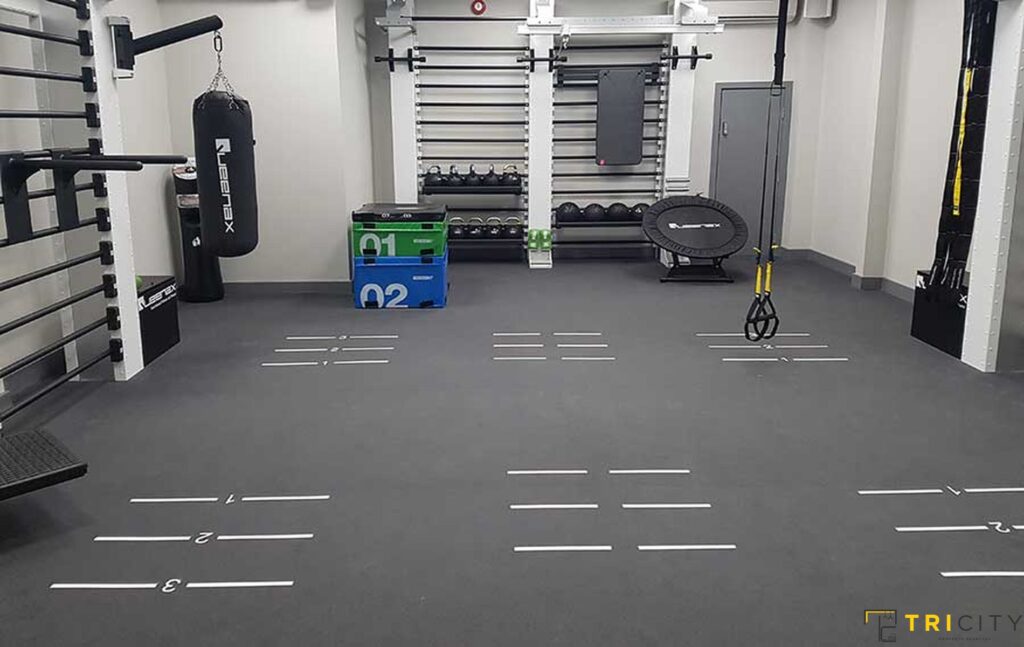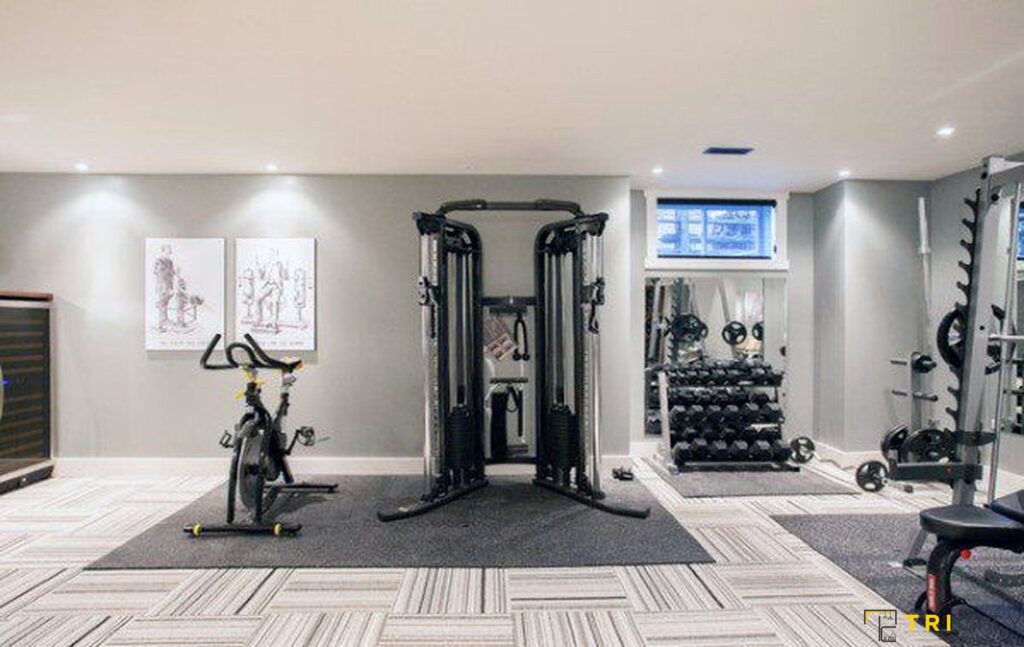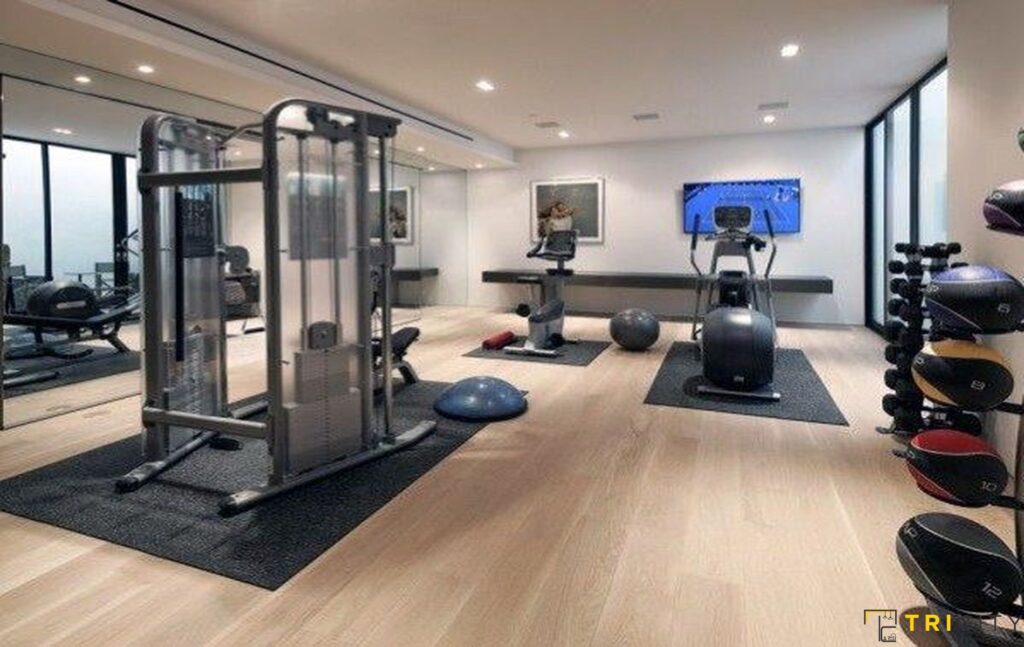Whether you hit the gym outside or try to build one in your house, its flooring is extremely important. The right flooring can help prevent injuries by providing a non-slip surface and cushioning for high-impact exercises. It can also protect your equipment and subfloor from damage caused by heavy weights and dropped equipment. Well! Keep the worries apart; consider one of these best home gym flooring ideas that we have brought to you in this article.
The idea of the article is to suggest you some flooring ideas for your home gym, which can give you comfortable flooring surfaces even if there is not enough space. These ideas can turn your gym into a comfortable and suitable place to help you stay motivated during your workouts and prevent fatigue and joint pain.
In addition to this, good flooring is also essential because it can be easy to clean and maintain. Besides, it helps in preventing the growth of bacteria and other microorganisms. It can protect your home gym from odors and prevent any health hazards.
8 Best Home Gym Flooring Ideas
We have compiled some of the best flooring options to enhance the overall look and feel of your home gym. These ideas can make your home gym a more inviting and enjoyable space to work out in.
Interlocking Foam Mats
Interlocking foam mats are a type of home gym flooring made from a lightweight foam material. They come in different thicknesses, sizes, and colors and are designed to interlock together like puzzle pieces to create a seamless surface.

One of the biggest advantages of interlocking foam mats is their affordability. They’re generally less expensive than other types of home gym flooring, making them a popular choice for budget-conscious homeowners.’=
Interlocking foam mats are also easy to install, as they require no adhesive or special tools. You simply connect the pieces together like a puzzle, and the mats stay in place.
Another benefit of interlocking foam mats is their cushioning properties. The foam material provides a soft surface that can absorb shock and reduce the impact of high-impact exercises, such as jumping or running.
However, interlocking foam mats may not be the best choice for all types of workouts. They’re not as durable as other types of flooring and may not hold up well under heavy equipment or repeated impact. They also have a tendency to compress over time, which can affect their cushioning properties.
Rubber Flooring
Rubber flooring is a popular option for home gyms, as it is durable, long-lasting, and can withstand heavy weights and high-impact exercises. It is made from recycled rubber materials and is available in rolls or tiles.

One of the main benefits of rubber flooring is its durability. Because they are durable, they are a great fit in your home gym. These can withstand heavy foot traffic, dropped weights, and other impacts without becoming damaged. This makes it a great choice for home gyms with heavy equipment, as it will not crack or chip under pressure.
Rubber flooring is also slip-resistant, which helps prevent accidents and injuries during workouts. It has a textured surface that provides traction, even when wet. This makes it the best bet for your home gym for high-intensity exercises.
In addition to its functional benefits, rubber flooring comes in several colors and patterns. You can easily customize the look of your home gym. It is also easy to clean and maintain, making it a hygienic choice for those concerned about bacteria and germs.
One downside of rubber flooring is that it can be more expensive than other types of home gym flooring, such as foam or vinyl. It can also have a distinct odor when first installed, although this usually dissipates over time.
Vinyl Flooring
Vinyl flooring is a popular, as it is affordable, durable, and easy to maintain. It is made from synthetic materials and is available in a wide range of colors and patterns.

Vinyl flooring is affordable. It is generally less expensive than other types of home gym flooring, such as rubber or hardwood. This makes it a great choice for those on a budget who still want a durable and functional flooring surface.
Vinyl flooring is also durable and long-lasting. It is resistant to scratches, stains, and wear and tear, and it can withstand heavy foot traffic and dropped weights. It is also moisture-resistant, making it a good choice for home gyms that may experience spills or dampness.
Another advantage of vinyl flooring is its ease of maintenance which makes it easy to clean and sanitize. It does not require any special treatments or finishes to maintain its appearance.
However, vinyl flooring may not be as cushioned as other types of flooring, such as foam or rubber, which can be a concern for those who do high-impact exercises. It can also be prone to tearing or puncturing if sharp or heavy objects are dropped on it.
Carpet Tiles
Carpet tiles are made from small squares of carpet that can be installed in a modular fashion to create a seamless surface. They are typically made from synthetic materials, such as nylon or polyester, and are available in a variety of colors and patterns.

One of the main benefits of carpet tiles is their cushioning properties. They provide a soft surface that can absorb shock and reduce the impact of high-impact exercises, such as jumping or running. This makes them one of the best home gym flooring ideas for those who want a comfortable flooring surface for their home gym workouts.
Carpet tiles are also easy to install and replace. They can be installed over any flat, clean surface without the need for adhesive or special tools. And if a tile becomes stained or damaged, it can be easily replaced without having to replace the entire flooring surface.
Another advantage of carpet tiles is their noise-reducing properties. They can help to reduce the noise of heavy equipment and footfalls, making for a quieter workout environment.
However, carpet tiles can be difficult to clean and may trap dust, dirt, and other allergens, which can be a concern for those with allergies or respiratory issues. They can also be prone to wear and tear, especially in high-traffic areas, which can affect their cushioning properties over time.
Cork Flooring
Cork flooring is a natural and sustainable option for home gym flooring. It is made from the bark of the cork oak tree and is available in tiles or planks. Cork flooring is known for its unique look, durability, and comfort.

Cork flooring can be a great home gym idea because of its cushioning properties. It is naturally springy and absorbs shock, making it a comfortable and safe surface for high-impact exercises. It is also slip-resistant, which can prevent accidents and injuries during workouts.
It is also durable and long-lasting. It is resistant to wear and tear, scratches, and stains and can withstand heavy foot traffic and dropped weights. It is also hypoallergenic and antimicrobial, which makes it a great choice for those with allergies or respiratory issues.
Another advantage of cork flooring is its natural insulation properties. It is a good insulator of both heat and sound, which can make your home gym more energy-efficient and reduce noise pollution in your home.
However, cork flooring may require more maintenance than other types of home gym flooring. It may need to be sealed periodically to maintain its appearance and prevent water damage. It is also more susceptible to fading and may require UV protection if exposed to direct sunlight.
Hardwood Flooring
Hardwood flooring is a classic and elegant choice. It is made from natural wood and is available in a variety of species and finishes. Hardwood flooring is known for its durability, beauty, and versatility.

One of the main benefits of hardwood flooring is its durability. It is resistant to wear and tear, scratches, and stains, and can withstand heavy foot traffic and dropped weights. It can also last for decades with proper maintenance, making it a long-term investment for your home gym.
Hardwood flooring is also beautiful and timeless. It adds warmth and elegance to any room and can be customized to fit any style or design preference. It is also versatile and can be used in other areas of your home, which can create a cohesive and seamless look throughout your living space.
Another advantage of hardwood flooring is its ease of maintenance. It is easy to clean and can be sanded and refinished to remove scratches and maintain its appearance. It is also hypoallergenic and does not trap dust, dirt, or allergens, which can improve the air quality in your home.
However, it can be slippery, which can increase the risk of accidents and injuries during high-intensity exercises. This flooring can also be noisy, especially if installed over a concrete slab or in a multi-story home.
Artificial Turf
Artificial turf is a synthetic grass-like surface that can be used as a flooring option for home gyms. It is typically made from polyethylene or polypropylene fibers that are tufted into a backing material.

Artificial turf is known for its durability, low maintenance requirements, and versatility.
One of the main benefits of artificial turf is its cushioning properties. It provides a soft and forgiving surface that can reduce the risk of injury during high-impact exercises such as running or jumping. It is also slip-resistant, which can prevent accidents and injuries during workouts.
Artificial turf is also durable and long-lasting. It is resistant to wear and tear, fading, and stains and can withstand heavy foot traffic and dropped weights. It is also low-maintenance and does not require watering, mowing, or fertilizing, which can save time and money.
It has high versatility. It can be used both indoors and outdoors and can be customized to fit any size or shape of the room. You can choose this flooring option in a variety of colors and pile heights, which can create a unique and personalized look for your home gym.
EVA Foam Tiles
EVA foam tiles are a type of interlocking foam mat that can be used as a flooring option for home gyms. They are made from ethylene-vinyl acetate (EVA) foam, which is a soft and lightweight material that provides cushioning and shock absorption.

One of the main benefits of EVA foam tiles is their comfort. They provide a soft and forgiving surface that can reduce the impact on your joints during high-impact exercises such as running or jumping. They are also slip-resistant, which can prevent accidents and injuries during workouts.
EVA foam tiles are also versatile and customizable. They are available in a variety of colors, thicknesses, and patterns, which can create a unique and personalized look for your home gym. They can also be easily installed and removed, which can make them a convenient option for those who want to change their flooring frequently.
EVA foam tiles are durable. They are resistant to wear and tear, moisture, and stains and can withstand heavy foot traffic and dropped weights. They are also easy to clean and can be wiped down with a damp cloth or vacuumed to remove dirt and debris.
However, EVA foam tiles can be less durable than other options and may need to be replaced more frequently. They may also be less resistant to odors and bacteria, especially if they are not cleaned regularly.
It’s a Wrap!
So these were the 8 hand-picked best home gym flooring ideas for you and chosing the most suitable depends on several factors, such as the type of exercises you will be doing, your budget, and your design preferences.
There are many different options to choose from, including interlocking foam mats, rubber flooring, vinyl flooring, carpet tiles, cork flooring, hardwood flooring, artificial turf, and EVA foam tiles.
Each option has its own advantages and disadvantages, and it’s important to weigh these factors carefully before making a decision. Ultimately, the right flooring can help create a safe, comfortable, and enjoyable workout space that will motivate you to achieve your fitness goals.
Also, check out how to create a home gym on a budget.







